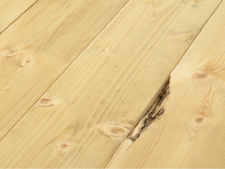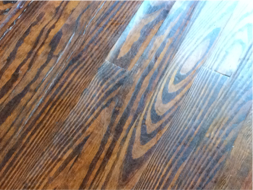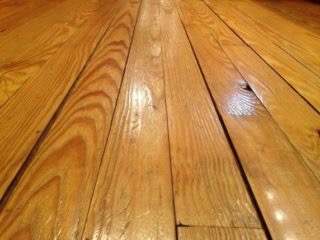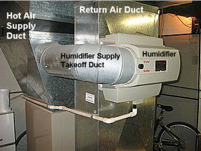Wisconsin Weather and Wood Flooring Woes-Avoiding Splits and Cracks
Posted by Aaron Schaalma
Because wood floors are predominantly an interior building product, the focus is often on interior living conditions only, without regard to how interior conditions are affected by exterior forces. Let’s talk about what I mean and why it is important for a little bit.
Installing a wood floor is can be a considerable liability if done without proper planning and communication before the first fastener is driven. In this business it appears simple, put in new flooring and leave after done. Within days of installation, a wood floor will begin to react to its new environment. Weather is constantly changing over time and contributes to a great number of floor failures annually. At the heart of the failures is moisture gain or loss. The duty of a wood floor professional is to determine how to optimize the balance in your home with thorough pre-planning. In this case, I want to discuss moisture loss and its affects over time.

All flooring composed of real wood (engineered or solid) has ideal conditions to stay happy. Without getting overbearing and geeking out on the above graphic, most floors like 30-50% humidity and temperatures in the 60-80 degree range. Deviating for short periods from this range is not problematic. However, ignoring the importance of these conditions for a long time will eventually ruin a wood floor investment. Unfortunately, the discussion of how to maintain these conditions usually never happens because it requires additional cost. Because people more often sell on cost instead of value, they shortchange this part of the process.
Let’s look at the real world consequences from overlooking the needs of your wood floors one by one:
Splinters or cracked boards

Around Wisconsin we have a true four season weather pattern giving us constantly fluctuating interior humidity levels. Over time, when wood fibers in flooring swell and shrink repeatedly, the cells inside can collapse or tear. This result is chipped boards, splinters, and loose boards. While these problems are “character” in an old house, they become annoying in most situations if not addressed. I have never met someone who didn’t lose their mind at a splinter in their feet from a wood floor.
Dry Cupping

Dry cupping happens when engineered floors shrink at differential rates between the real wood layer and plywood base. The idea that engineered wood floors are more stable than solid flooring is a statement with several caveats. For brevity, the best advice is to know that even engineered floors require living conditions that solid wood floors need, except they are somewhat more tolerant of short term deviations.
Gaps

Dimensional shrinkage of wood floors is often lumped into the one category of “seasonal movement”. The truth is that it is more complicated to diagnose wood floor shinkage sources despite knowing the cause
I often hear people complain about gaps and cracks as a responsibility of the wood floor contractor alone. We can plan and do the job well, but how the floor is maintained involves more than simple cleaning.
The early spring season around Wisconsin and the midwest is typically the time when a floor will say uncle to an aggressive heating cycle. As I travel to visit customers in Neenah, Appleton, etc…I see more wood floor gaps at this time of year. In the spirit of education, I figured I would share a few solutions that will help you.
HVAC integrated humidification

The cost to add humidity to your forced air heater is generally not that bad. Although you may spend $1000-3000 depending on the size of your home, it is a great solution to preserve a wood floor. The cost is actually not bad, when you consider that a lot of wood floor installations can easily exceed $10,000 or more. People who want floors with wider boards should add humidity in their home. In fact, almost all wood floor manufacturer instructions require 30-50% humidity in the home to maintain warranties. I recommend a hygrometer (preferably good quality) as a beginning point to monitor your home. I have been asked if stand-alone humidifiers work. These units work will in small areas such as bedrooms, but houses are too large in most cases.
Supplemental moisture
If a whole house humidification system is not in the budget, there are a few simple approaches that you can consider:
- Open bathroom doors after taking a shower
- Open the dishwasher after it finishes its cycle
- Add plants to your home. They add moisture to a space via transpiration
- Operate several standalone humidifiers throughout the home.
Aggressive heating cycles are a major cause for the problems I have mentioned. Although we need heat to live comfortably, it is best that we know the consequences if you love wood floors as much as me. We simply need to know how to identify the problem and how to fix it.
We consider ourselves craftsmen and wood floor preservation and restoration specialists. Next time we will cover how to fix the after effects of flooring that has lost moisture beyond its comfort zone. See how I transform spaces by refinishing and restoring the floors.



